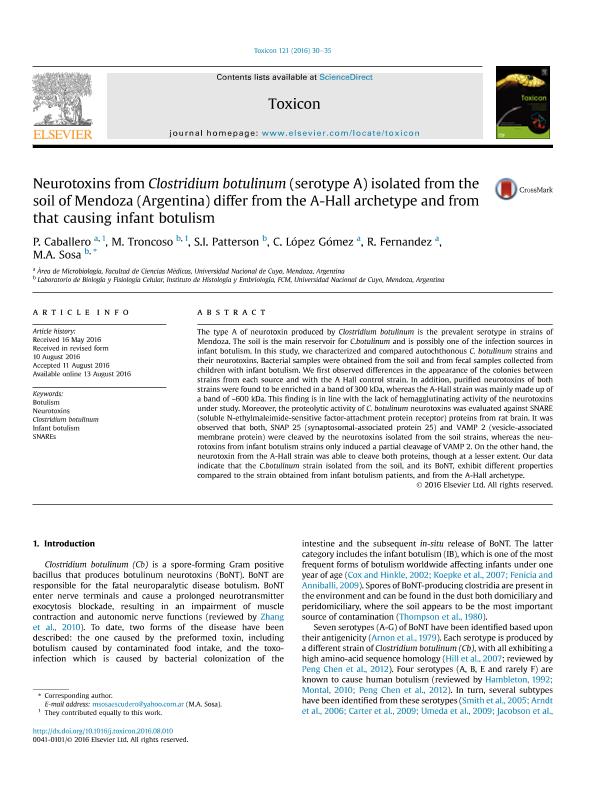Mostrar el registro sencillo del ítem
dc.contributor.author
Caballero, P.
dc.contributor.author
Troncoso, Mariana Elizabeth

dc.contributor.author
Patterson, Sean Ingram

dc.contributor.author
Lopez Gomez, C.
dc.contributor.author
Fernandez, R.
dc.contributor.author
Sosa Escudero, Miguel Angel

dc.date.available
2018-06-19T18:13:38Z
dc.date.issued
2016-10
dc.identifier.citation
Caballero, P.; Troncoso, Mariana Elizabeth; Patterson, Sean Ingram; Lopez Gomez, C.; Fernandez, R.; et al.; Neurotoxins from Clostridium botulinum (serotype A) isolated from the soil of Mendoza (Argentina) differ from the A-Hall archetype and from that causing infant botulism; Pergamon-Elsevier Science Ltd; Toxicon; 121; 10-2016; 30-35
dc.identifier.issn
0041-0101
dc.identifier.uri
http://hdl.handle.net/11336/49357
dc.description.abstract
The type A of neurotoxin produced by Clostridium botulinum is the prevalent serotype in strains of Mendoza. The soil is the main reservoir for C.botulinum and is possibly one of the infection sources in infant botulism. In this study, we characterized and compared autochthonous C. botulinum strains and their neurotoxins. Bacterial samples were obtained from the soil and from fecal samples collected from children with infant botulism. We first observed differences in the appearance of the colonies between strains from each source and with the A Hall control strain. In addition, purified neurotoxins of both strains were found to be enriched in a band of 300 kDa, whereas the A-Hall strain was mainly made up of a band of ∼600 kDa. This finding is in line with the lack of hemagglutinating activity of the neurotoxins under study. Moreover, the proteolytic activity of C. botulinum neurotoxins was evaluated against SNARE (soluble N-ethylmaleimide-sensitive factor-attachment protein receptor) proteins from rat brain. It was observed that both, SNAP 25 (synaptosomal-associated protein 25) and VAMP 2 (vesicle-associated membrane protein) were cleaved by the neurotoxins isolated from the soil strains, whereas the neurotoxins from infant botulism strains only induced a partial cleavage of VAMP 2. On the other hand, the neurotoxin from the A-Hall strain was able to cleave both proteins, though at a lesser extent. Our data indicate that the C.botulinum strain isolated from the soil, and its BoNT, exhibit different properties compared to the strain obtained from infant botulism patients, and from the A-Hall archetype.
dc.format
application/pdf
dc.language.iso
eng
dc.publisher
Pergamon-Elsevier Science Ltd

dc.rights
info:eu-repo/semantics/openAccess
dc.rights.uri
https://creativecommons.org/licenses/by-nc-sa/2.5/ar/
dc.subject
Botulism
dc.subject
Clostridium Botulinum
dc.subject
Infant Botulism
dc.subject
Neurotoxins
dc.subject
Snares
dc.subject.classification
Otras Ciencias Biológicas

dc.subject.classification
Ciencias Biológicas

dc.subject.classification
CIENCIAS NATURALES Y EXACTAS

dc.title
Neurotoxins from Clostridium botulinum (serotype A) isolated from the soil of Mendoza (Argentina) differ from the A-Hall archetype and from that causing infant botulism
dc.type
info:eu-repo/semantics/article
dc.type
info:ar-repo/semantics/artículo
dc.type
info:eu-repo/semantics/publishedVersion
dc.date.updated
2018-06-13T16:53:18Z
dc.journal.volume
121
dc.journal.pagination
30-35
dc.journal.pais
Países Bajos

dc.journal.ciudad
Amsterdam
dc.description.fil
Fil: Caballero, P.. Universidad Nacional de Cuyo. Facultad de Ciencias Médicas; Argentina
dc.description.fil
Fil: Troncoso, Mariana Elizabeth. Consejo Nacional de Investigaciones Científicas y Técnicas. Centro Científico Tecnológico Conicet - Mendoza. Instituto de Histología y Embriología de Mendoza Dr. Mario H. Burgos. Universidad Nacional de Cuyo. Facultad de Cienicas Médicas. Instituto de Histología y Embriología de Mendoza Dr. Mario H. Burgos; Argentina
dc.description.fil
Fil: Patterson, Sean Ingram. Consejo Nacional de Investigaciones Científicas y Técnicas. Centro Científico Tecnológico Conicet - Mendoza. Instituto de Histología y Embriología de Mendoza Dr. Mario H. Burgos. Universidad Nacional de Cuyo. Facultad de Cienicas Médicas. Instituto de Histología y Embriología de Mendoza Dr. Mario H. Burgos; Argentina
dc.description.fil
Fil: Lopez Gomez, C.. Universidad Nacional de Cuyo. Facultad de Ciencias Médicas; Argentina
dc.description.fil
Fil: Fernandez, R.. Universidad Nacional de Cuyo. Facultad de Ciencias Médicas; Argentina
dc.description.fil
Fil: Sosa Escudero, Miguel Angel. Consejo Nacional de Investigaciones Científicas y Técnicas. Centro Científico Tecnológico Conicet - Mendoza. Instituto de Histología y Embriología de Mendoza Dr. Mario H. Burgos. Universidad Nacional de Cuyo. Facultad de Cienicas Médicas. Instituto de Histología y Embriología de Mendoza Dr. Mario H. Burgos; Argentina
dc.journal.title
Toxicon

dc.relation.alternativeid
info:eu-repo/semantics/altIdentifier/url/http://www.sciencedirect.com/science/article/pii/S0041010116302434
dc.relation.alternativeid
info:eu-repo/semantics/altIdentifier/doi/http://dx.doi.org/10.1016/j.toxicon.2016.08.010
Archivos asociados
